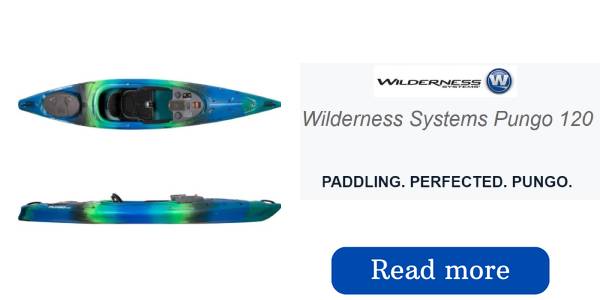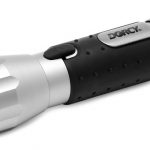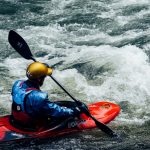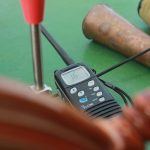You and your family’s safety should be your top priority when you are kayaking or fishing. Mishaps and accidents can happen at any time in the water without any warning.
A kayak fishing PFD can save your life in the event of an accident in the water.
Many states have made it a rule to wear a PFD or life vest when you are in the water. This will ensure that your head remains over the water surface.
The following article will provide guidance on how to select the best life jacket for kayak fishing.
Don’t go anywhere. Stay tuned.
Best Kayak Fishing PFD – Review
We compiled a list of the 10 best PFDs for kayak fishing after reviewing many different options.
NRS Chinook Fishing PFD
The NRS Chinook Fishing PFD is a practical solution for anglers who want to be well-equipped while fishing or kayaking. The Class-3 PFD is designed to provide peace of mind and maximum utility for the wearer.
The PFD has 8 front pockets where you can store your belongings like a phone or power bar. It also has loops that you can use to snap items when necessary. With 8 adjustable points, the PFD can be made to fit anyone comfortably.
This PFD is perfect for canoe tripping because it has a ventilated back panel that ensures proper ventilation on a humid day. The mesh lower back also guarantees better relaxation while kayaking.
The 200-denier urethane-coated ripstop nylon outer fabric makes this item very durable. It is also very affordable and has many features.
Pros
- Roomy front-entry design.
- 8-adjustable points that allow its user to adjust the PFD for better comfort.
- Ventilated mesh lower-back panel.
- Universal size option.
Cons
- Unavailability of water bladder pouch.
Stearns Child Watersport Classic Series Vest
The Stearns Child Watersport Classic Series Vest is designed for children aged 30-50 pounds. The closed sides stops the child from sliding out, and the leg straps keep the vest in the right position.
This PFD will dry quickly and remain lightweight most of the time due to the drainage holes in it. Your children will be forced to sit upright while wearing it, which is undoubtedly a great thing. Stearns has kept every possible opportunity to ensure the safety of your children on the water in mind.
Its long-lasting nylon structure over PE foam confirms that the PFD is built to give many years of service.
This product will ensure your children are comfortable at all times. It comes with three adjustable chest belts and one adjustable crotch strap. Additionally, the two large armholes allow for easy movement even when in the water.
Most importantly, this is a PFD approved by the US Coast Guard. You can also choose from three different color options for this durable chest vest, which promises to provide you with years of service.
Pros
- Durably made.
- Nylon structure over PE foam.
- Drainage holes to keep the PFD dry and lightweight always.
- US coast guard approved.
Cons
- Small size.
Stohlquist Fisherman Personal Floatation Device
This PFD is similar to others made for kayaking and fishing in that it provides safety and comfort and has storage space. It will help you overcome any obstacles you encounter while on the water and because everything you need is within easy reach, you won’t have to fumble around in your kayak to find it.
The vest is made of 500-denier Cordura shell, 200-denier oxford liner, and a type of nylon that is water-proof. With more adjustment features than other personal floatation devices, this chest vest will give you an extended period of service.
The pad on the shoulder of this life jacket is made from water-resistant neoprene fabric. The chest vest is designed to allow air to flow through it, so the person wearing it will feel comfortable. The PFD gives the wearer more freedom of movement in their shoulders than is usual, so they can move freely.
The PFD has several pockets which make it ideal for anglers to store equipment and other belongings. The best thing about the PFD is that is it easily washable with just a hand wash using soap and warm water.
Onyx Curve MOVEMENT Paddle Sports PFD
If you are looking for a PFD that is affordable and does not restrict your movement, this Onyx Curve MOVEMENT Paddle Sports PFD is the perfect option for you. It is designed to provide extreme comfort to its users and allows them to move without any hassle.
The chest vest is designed to allow you to move freely. Air can pass through the vest easily, so you will feel cooler when you exert yourself. The adjustments are easy to adjust as necessary. The back and shoulder contain flotation foam and bubble, and the shoulder has neoprene pads for comfort.
The vest comes in different sizes that you will need to pick according to your weight. The vest’s bright yellow color will help your partner keep an eye on you when you are far from him/her on the water, which is essential for visibility. However, the vest also comes in black and blue.
This PFD is perfect for kayak fishing because it is extremely comfortable and well ventilated. It is also very affordable, making it an excellent value for your money.
Pros
- Class-3 kayak fishing PFD.
- Comfortable design.
- Through proper ventilation features, your body remains cool.
- Lightweight.
USCG v ISO Personal Flotation Devices
We recently reviewed two low-volume/profile PFDs that have international safety certifications and are considered safe for use in countries like Australia, New Zealand, and South Africa.
Both have been popular in the surf ski community and are becoming attractive to SUP paddlers who are looking for a better alternative to the USCG-approved inflatable waist belt PFD, which they don’t think is safe.
We received some criticism for that. For example, some people said we should not have reviewed products that are not approved by the Coast Guard. We clearly explained in each review that the products were not USCG approved and users should use their own judgment in deciding whether to use them.
As a result of the discussion, we did some research to try to help figure out the differences between USCG and ISO regulations so that people can make informed decisions.
So this is where I start. This post is going to be long and I will include links to my sources.
What the USCG Says About PFDs
This is significant. This is directly from the USCG website:
” No single design for a life preserver, lifejacket, or personal flotation device (PFD) is perfect; all existing designs have some limitations. For example, Type I PFDs (off-shore lifejackets) have the highest buoyancy of the inherently buoyant Types, but they are not considered comfortable enough to be worn continuously.
Therefore, they are frequently not used when accidents occur, and many boaters have died that could have been saved with just part of the buoyancy in this kind of PFD. Another example is the inflatable Type III PFDs.
These recently approved PFDs provide the buoyancy of a Type I PFD and are comfortable to wear, but they lack the reliability and low maintenance characteristics, and cost, of inherently buoyant PFDs. Because each style has limitations, users are given a choice of PFDs to match their particular boating activities.
It is unlikely that any different type of PFD would have prevented most of the drownings where a PFD was used.”
- About 51 people died in accidents where PFDs were used, but only in a few of those cases is there any indication that a higher performing PFD might have prevented the drowning. In the majority of cases, other contributing factors would have overcome the benefits of any PFD. The factors include: being trapped in an overturned boat, being held under a boulder or log by the strong currents of white water, removing the PFD for some reason (like swimming to shore), becoming hypothermic due to the duration of exposure to cold water, suffering other injuries that led to drowning, etc.
- One is much more likely to drown while boating due to not wearing a PFD than wearing one with inadequate performance for conditions that occur only occasionally, and only at places and times that most boaters know to avoid. “
The PFDs
We will compare the ratings of the Mocke and Vaikobi life jackets to those of a United States Coast Guard Type III inherently buoyant life jacket.
- USCG Type III: 70 Newtons or 15.5 pounds of flotation
- Mocke Racer: 60 Newtons or 13.4 pounds of flotation.
- Vaikobi Ocean Racing: 50 Newtons or 11.2 pounds of flotation.
Both the USCG and Mocke PFDs offer more than the extra seven to 12 pounds of extra lift cited by the US Coast Guard and the Vaikobi comes close.
Most Type III PFDs have more than 70 N of flotation, which is above the minimum requirement. However, most of that flotation is in the bottom front panel, which can make self-rescue more difficult for people of different body shapes.
Many of us don’t bother to read the labels on life jackets to see how much flotation they provide.
There are certain tests you can perform at home. The United States Coast Guard (USCG) approves personal flotation devices (PFDs), but your body composition might require a more buoyant PFD than the 70N standard. To see if a USCG-approved PFD will still do the job, you can perform certain tests at home.
The USCG tells consumers to be sure to look at the labels of PFDs and buy one sized for their height and weight. And if offers these fit guidelines:
- Try on your PFD to see if it fits comfortably snugly. Then test it in shallow water to see how it handles.
- To check the buoyancy of your PFD in the water, relax your body and let your head tilt back. Make sure your PFD keeps your chin above water and you can breathe easily.
- Be aware: your PFD may not act the same in swift or rough water as in calm water. The clothes you wear and the items in your pockets may also change the way your PFD works.
- If your mouth is not well above the water, get a new PFD or one with more buoyancy.
- A PFD is designed not to ride up on the body when in the water. But, when a wearer’s stomach is larger than the chest, ride-up may occur. Before use, test this PFD in the water to establish that excessive ride-up does not impair PFD performance.
Make sure the life jacket you purchase can keep your head above water and that it fits snugly.




